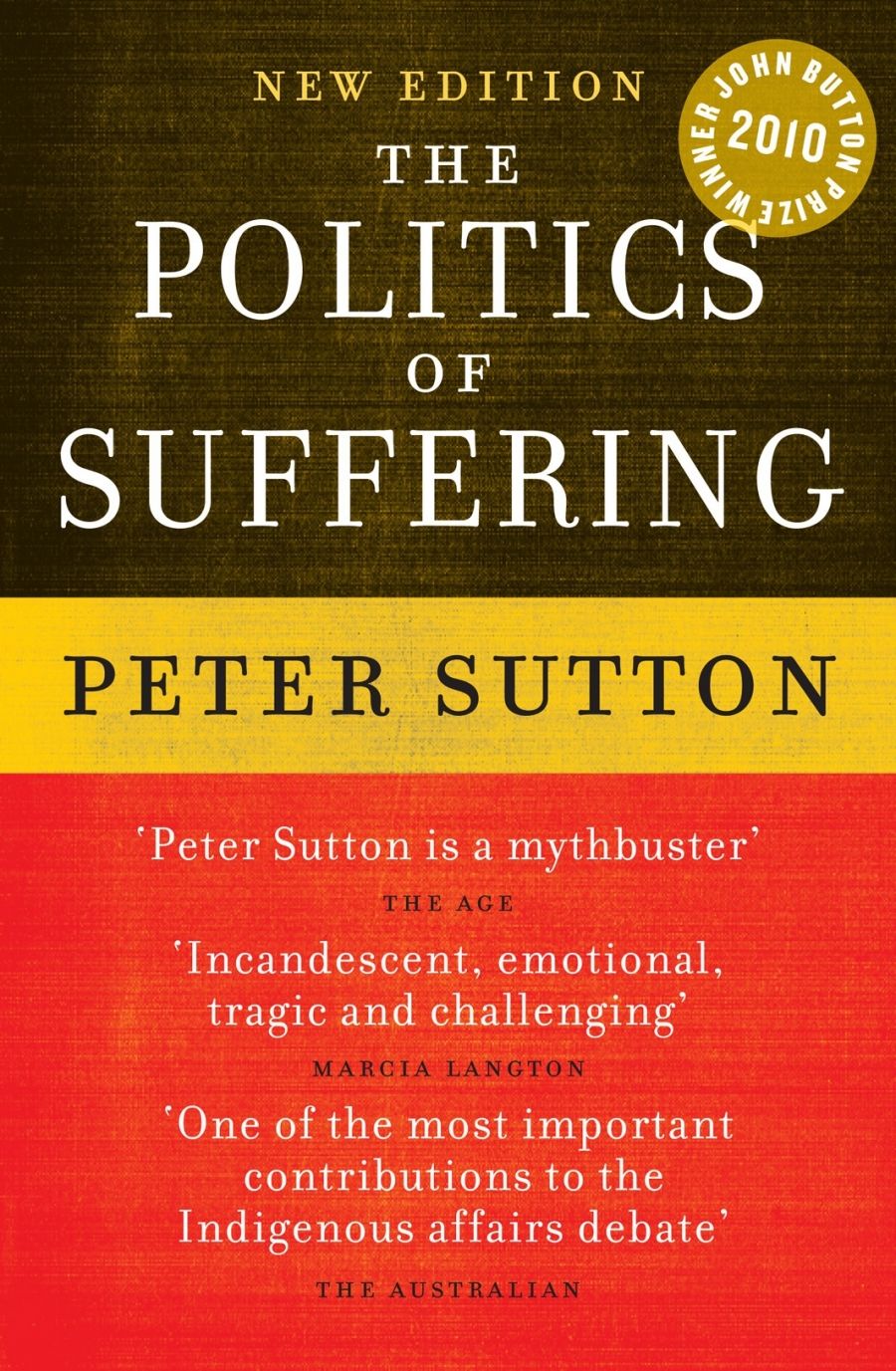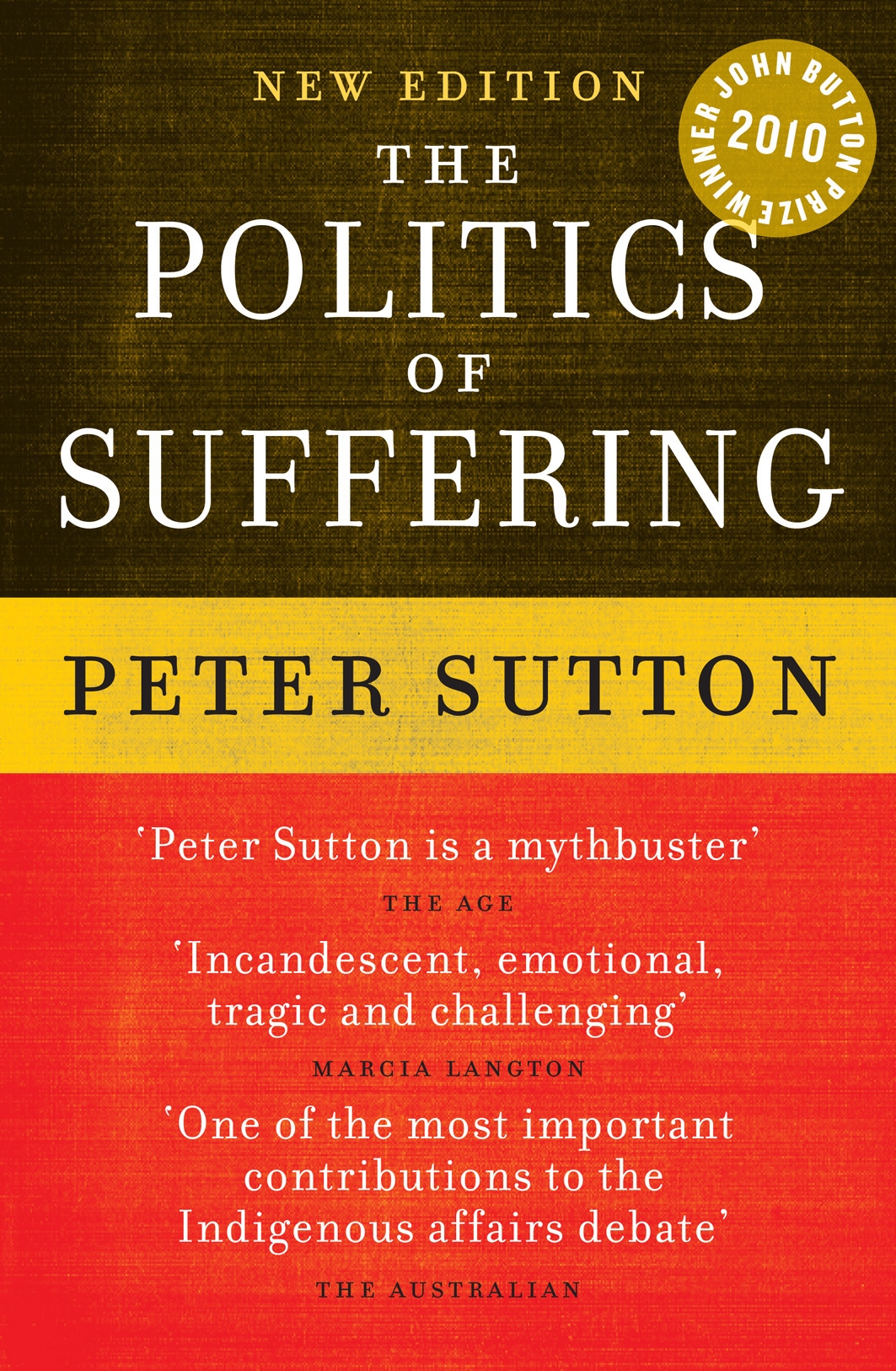
- Free Article: No
- Contents Category: Politics
- Review Article: Yes
- Article Title: Sustaining fictions
- Article Subtitle: Challenging the politics of embarrassment
- Online Only: No
- Custom Highlight Text:
This is a complex book from an anthropologist who has carried out research and established close relationships with indigenous people for four decades. Peter Sutton has lived through and participated in the Aboriginal protest movement from the early 1970s onwards, done extensive studies in support of securing tradition-based rights in land, and faced firsthand the well-publicised tragedies of many indigenous communities.
- Book 1 Title: The Politics of Suffering
- Book 1 Subtitle: Indigenous Australia and the end of the liberal consensus
- Book 1 Biblio: Melbourne University Press, $34.99 pb, 280 pp
- Book 1 Cover Small (400 x 600):

- Book 1 Cover (800 x 1200):

The book hits hard at those who would explain all Aboriginal disadvantage in terms of a ‘sustaining fiction’: that ‘external impacts alone’ are the cause, and more significantly, that solutions lie in politicised visions of indigenous separatism. Sutton worries about the ‘corrosive effect’ of a ‘delusional politics’, including attitudes of White guilt, on the ability to see clearly the need for ‘a deep … cultural redevelopment’ if ‘there is to be a radical improvement in [Aboriginal] people’s chances of ending their suffering’.
Sutton’s passion transparently derives from the tragedies he has witnessed. The book opens with a harrowing account of a Wik woman at Aurukun, on Cape York Peninsula – a person whom he called ‘niece’ through his incorporation into the kinship system, and who hanged herself in 1998 at the age of twenty-seven. Formerly a lively child at an outstation that Sutton helped establish in the 1970s, by the 1990s she was drinking heavily, repeatedly bashed, and twice examined in hospital after giving details of how she was pack-raped by local Aboriginal boys. A stream of such horrific events over the past two decades or more has led this talented researcher to despair at what he terms ‘ersatz, cavalier, causal theory’. While of one mind with a number of leading scholars and writers on these issues (Aboriginal commentators among them), he is at odds with other colleagues in the academy and indigenous affairs over how best to understand both the causes and solutions of this crisis.
A key aspect of the debate concerns the need for government intervention in Aboriginal communities to impose, where necessary, restrictions on the people who may be giving insufficient attention to the care of children, who are choosing spending priorities that perpetuate ill health, or who may be continuing a pattern of entrenched episodic violence, especially towards women. In Sutton’s view, the ‘progressive politics’ stemming particularly from the Aboriginal rights movement in the 1970s dulled supporters’ instincts ‘about the sanctity of Indigenous people’s right also to be free from violence, abuse, neglect, ignorance and corruption’. He wants change from within Aboriginal culture as well as a sophisticated policy régime that is not seduced by what other anthropologists have for some time termed a post-colonial ‘politics of embarrassment’. Valuable though this politics has been in leveraging indigenous rights in the wake of colonisation, in Sutton’s estimation such achievements as land rights and native title have not led to ‘any demonstrable improvements in social welfare’.
Does this view risk ignoring the vastly improved bargaining position that has come with these rights: for example, in the negotiation of financial and employment benefits from large resource development projects, and the highly valued symbolic meaning for those Aboriginal people whose tradition-based relationships to ‘country’ have been publicly acknowledged by the Australian legal system? While the answer will vary with particular regions across the continent, on this issue I depart from Sutton’s downplaying of its significance.
If the author is ambivalent on this point, it is because his further concern is that such legal struggles for distinctively indigenous rights have been linked with a counter-productive separation of key service delivery. There is too much ‘bureaucratic, political and financial cocooning of Indigenous Australia’, he asserts, whether in health, housing, education, employment or legal provisioning. For example, in the area of health, Sutton argues that there ‘is no practical evidence for racial separatist politics as a cure for extreme rates of renal failure, ischaemic heart disease, high infant mortality and … domestic suicide’.
Yet, in many remote communities, it is mainstream government-funded health departments that run hospital facilities. Is it ‘cocooning’ to provide these services in predominantly Aboriginal towns? Surely not, unless it is the continued existence of the towns themselves that should be questioned. Indeed, Sutton provocatively asks whether these ‘outback ghettos’, dependent on welfare benefits, ought to receive continued funding, on which they depend for institutional existence. The obvious issue here is whether the populations currently spread across dozens of remote communities will do any better once relocated to larger regional towns. For that matter, will there be a lessened sense of ‘ethnic separatism’?
The author points us to the politically potent belief, so often taken for granted, that it is necessarily other Aboriginal people who best administer essential services to indigenous clients. He is, in my view, correct to raise the need for evidence-based answers to this question. However, regardless of what we might find, it would seem counter-productive not to take seriously the strong support for Aboriginal ‘ownership’ of service provision, at least among the hundreds if not thousands of indigenous people now working in child care, medical, education and legal services. Listeners to any radio station devoted to Aboriginal issues are constantly reminded how strongly entrenched is the ideology of ‘our mob’: that is, those who assert an indigenous identity, and who are believed to share fundamental characteristics regard-less of how diverse are their life experiences and cultural backgrounds. Commitment to the idea of such ethnic separateness cannot be wished away regardless of whether it is philosophically agreeable or practically useful.
Sutton’s aim, in part, is to ponder the future. According to national census data, couples with both an indigenous and non-indigenous partner are becoming increasingly common. There is an ‘advancing integration’; the proportion of such couples among Aboriginal people rose from forty-six per cent in 1986 to 71.5 percent in 2006. But this is not leading to any reduction among those asserting an Aboriginal or Torres Strait Islander identity, with eighty-seven per cent of the children of inter-racial unions so identified. The author suggests that in urban Australia, ‘Aboriginality is increasingly a political status’, though this proposition would doubtless be contested among many who argue for the cultural roots of the identity they have chosen to embrace. It is contentious to argue that the ‘ethnic separatist movement’ is strongest ‘among Western-educated Indigenous people in the bureaucracies’ because their careers often benefit. Nevertheless, there is substance to the proposition that, despite integration in their personal lives, such people can be ideologically committed to an ideal of separatism that lacks local support and is unhelpful for policy and practice in the remote communities.
Sutton’s contribution is equally controversial, though usefully so, on why changes to some cultural practices are necessary in addressing the crises in indigenous lives. Despite ‘culture’ becoming central to the ‘verbal currency of Indigenous liberation politics’ from the 1970s, and indeed from the early 1990s being critical to proving tradition-based native title rights, in the author’s view various practices and beliefs derived at least in part from Aboriginal traditions are a critical dimension of the problem. Examples include always privileging kin relations, defending one’s relatives’ innocence regardless of the facts, belief in sorcery as an exonerating factor in cases of violent crime rather than blaming the perpetrators, and continuing a pre-contact pattern of violence towards women.
Then there are ‘culturally embedded behaviours that have a direct impact on health’, including practices relating to ‘domestic sanitation and personal hygiene, housing density, [and] diet’. Traditional ‘doctors’ should not be accommodated by medical institutions if they encourage mystification about disease causation and alleged cures. Sutton’s complaint is that these issues are ignored in public policy in favour of political arguments for self-determination and the politics of representation. As in any cultural milieu, socialising children away from deeply embedded values presents an enormous practical challenge; it also raises the ethical question of convincing adults that aspects of everyday life, about which some may feel considerable pride, should be expunged from what is taught to children. Yet it is hard not to agree that there is too much idealising and romanticising of ‘the classical Aboriginal past’. As Sutton says, this ‘does no justice to the evidence and no service of historical truthfulness towards the very people one may admire and respect’.
This book is as much about Whitefellas as it is about Aboriginal people. Sutton is well placed to point out the continuing risk of posturing on the part of those arguing for an uncomplicated nobility in traditional culture. The lure of an exotic tribal world, one that can be construed as a romantic alternative to ‘the creeping mower of industrialization and its uniformities’, influences some Blackfellas and Whitefellas alike towards rhetoric of questionable value. There are people who work and/or write in ‘perpetual protest mode’, making commentary on indigenous affairs a vehicle for articulating their personal and passionate critique of the broader society. The great value of Sutton’s contribution, foreshadowed in Marcia Langton’s foreword, is that it speaks critically to both progressive romantics and carping neo-conservatives. While readers of different political persuasions will find ideas to dispute and promote, there is no question that their debates will be enriched by the provocative intellect evident throughout the book.


Comments powered by CComment